
In the summer prime sale at Amazon, we purchased a third-generation Amazon Echo Dot which is a small voice-controlled speaker using Amazon’s Alexa voice command service. Part Two of this post is on Echo Dot 3rd Gen Digging Deeper.
As this is the first Amazon echo dot device we have purchased, we decided to take it apart to see what you get for your £22.00.
In the Box
- The echo dot
- 240V UK power supply
- Things to try leaflet
- Setup instructions
- echo dot terms of use.
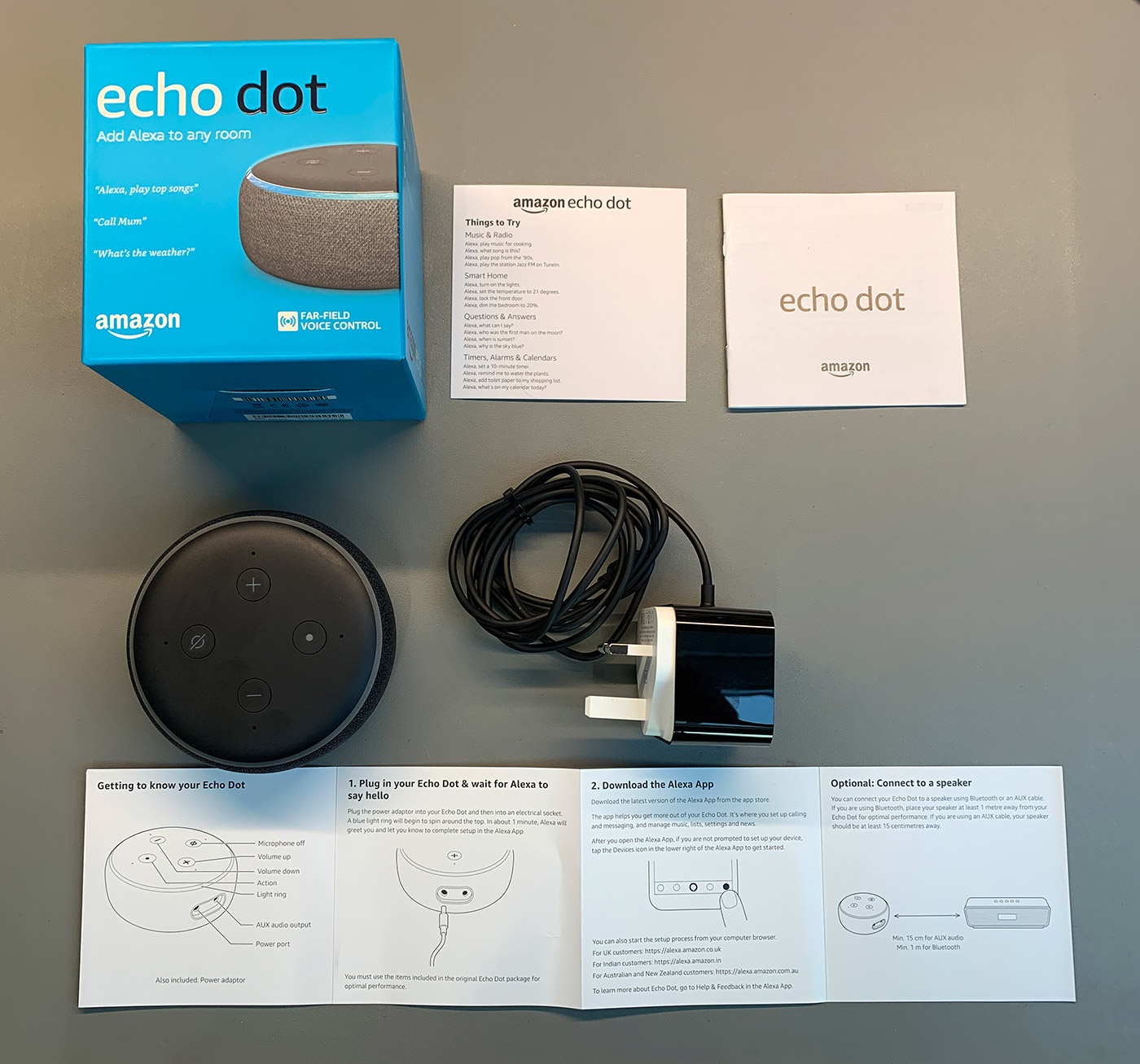
Your Raspberry Pi Projects Start Here
Please support the blog and our projects by buying your Raspberry Pi development boards and accessories from our online store at AB Electronics UK.
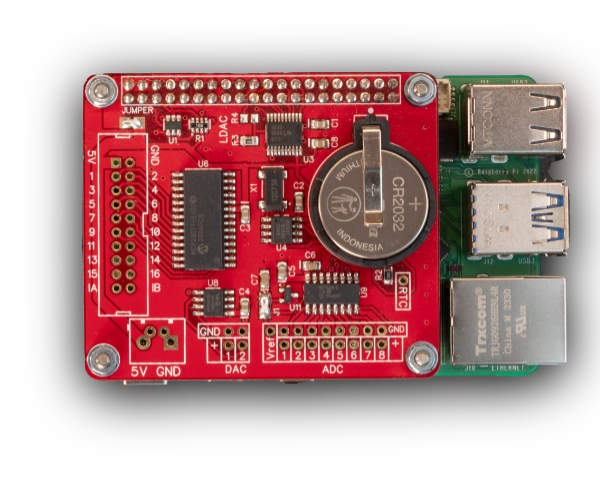
Top of the Echo
The top of the echo dot has four buttons, four microphones and an LED ring. The + and – buttons control the volume, the white circle activates Alexa and the circle with a line through it enables or disables the microphones.
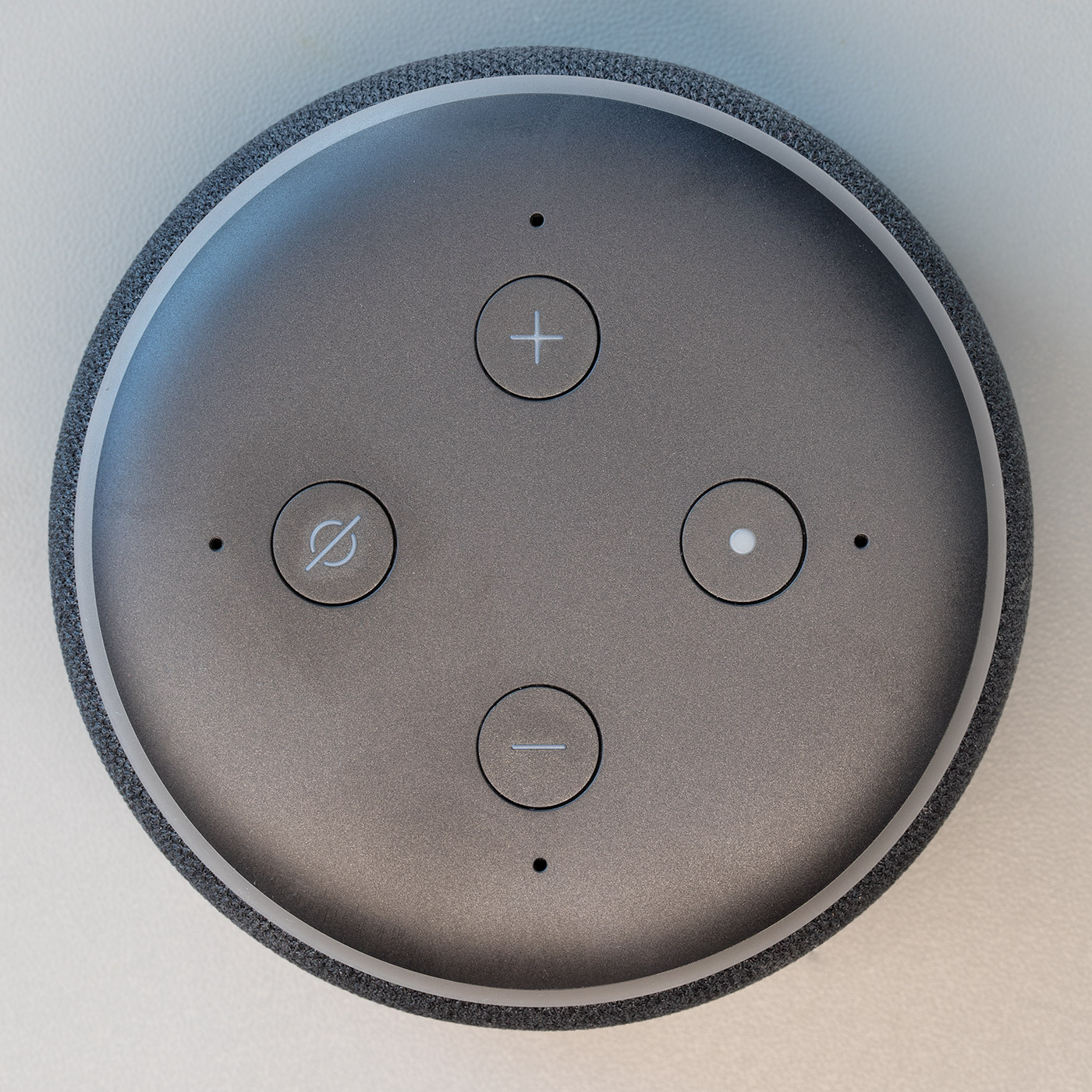
Case Base
The base has the serial number, product logos and certification marks.
On the side are a power input socket and headphone/audio out 3.5mm stereo socket.

Case Base with sticky foot removed
The cover is held in place using adhesive tape and four plastic locator pins.
To open the case first you need to remove the non-slip cover on the base of the echo dot, using a thin knife or some other flat-bladed tool.
Under the cover, you will find four Torx bolts and a recessed six-pin header which appears to be a debug or programming port.
Removing the four Torx bolts allows you to remove the plastic base.
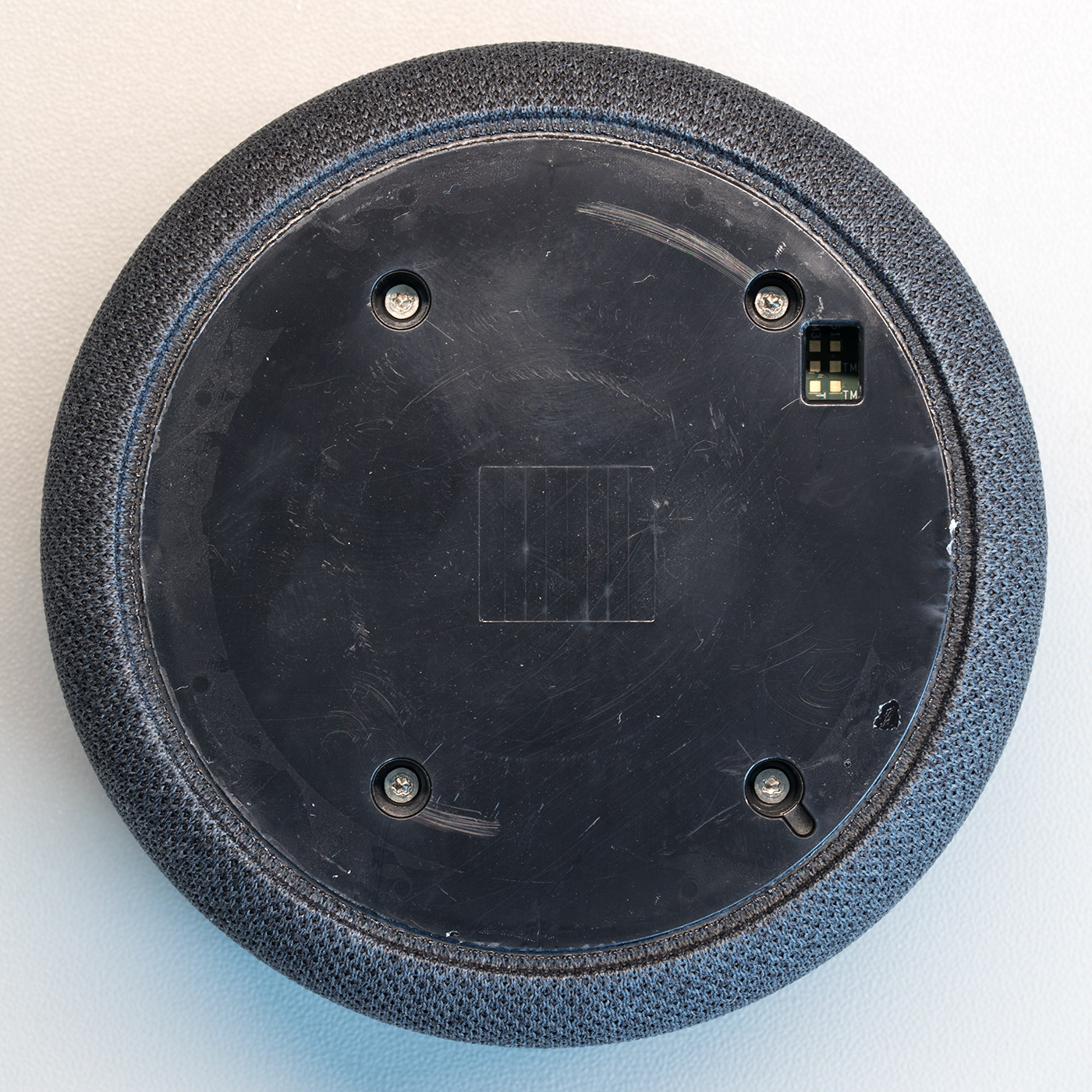
Metal Chassis with Processor PCB and speaker
Inside you will find a circuit board and an internal speaker.
The underside of the PCB contains discrete components and several test points.
The base PCB is removed using three Torx bolts and the removal of a small flat-flex cable. The four bolts that hold the power and headphone connectors down do not need to be removed.
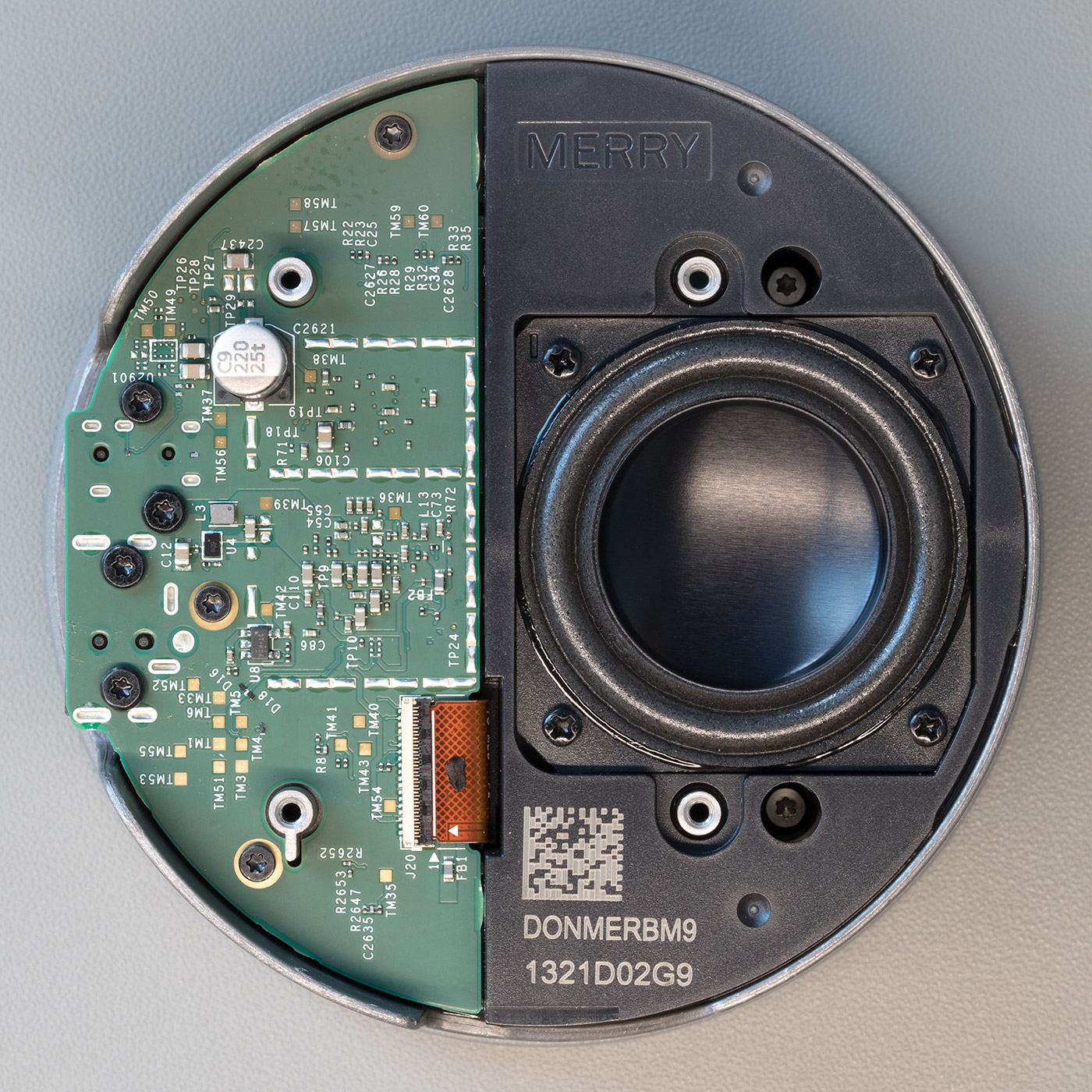
Metal Chassis with Speaker
The Metal chassis contains the speaker and plastic moulding for the speaker. The plastic is glued to the metal chassis, so we did not try to remove this.
There are four recessed Torx bolts which hold the top panel to the metal chassis.
Removing these allows you to remove the top PCB and button panel.
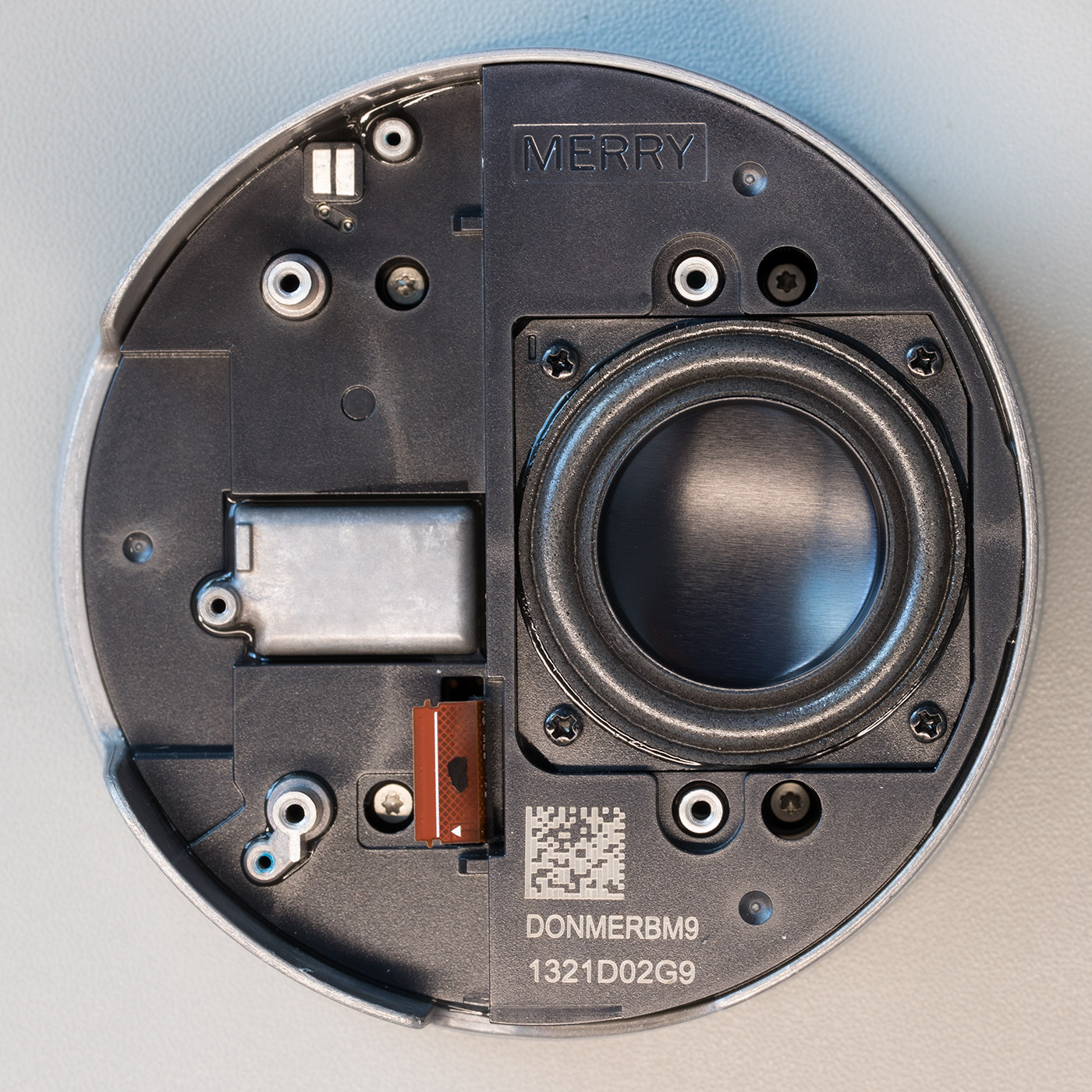
Processor PCB
The processor PCB houses the power input jack and a headphone/audio out port via a 3.5mm stereo headphone plug. There is a shielded section which houses the main processor and memory ICs.
The board also contains power regulation and the audio driver for the internal speaker which is a TAS2770 from Texas Instruments.
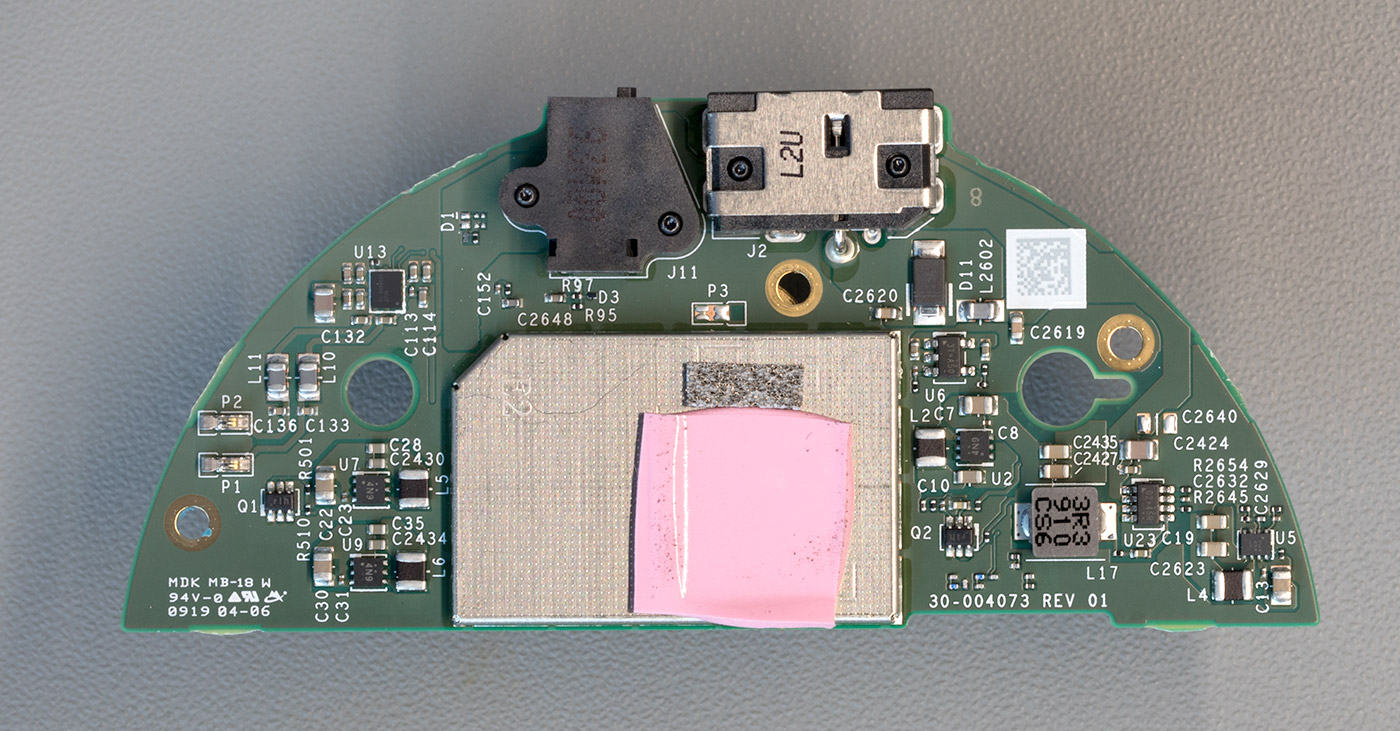
Processor PCB with shielding removed
The metal shield can be removed using a small screwdriver. Under the shield, you will find the Echo Dot's main CPU and Flash memory.
The Echo Dot uses a Mediatek MT8516BAAA Quad-core, 64-bit ARM® Cortex-A35 MPCore processor.
Next to the processor is a Samsung KMFN60012M-B214 8GB eMMC memory chip.
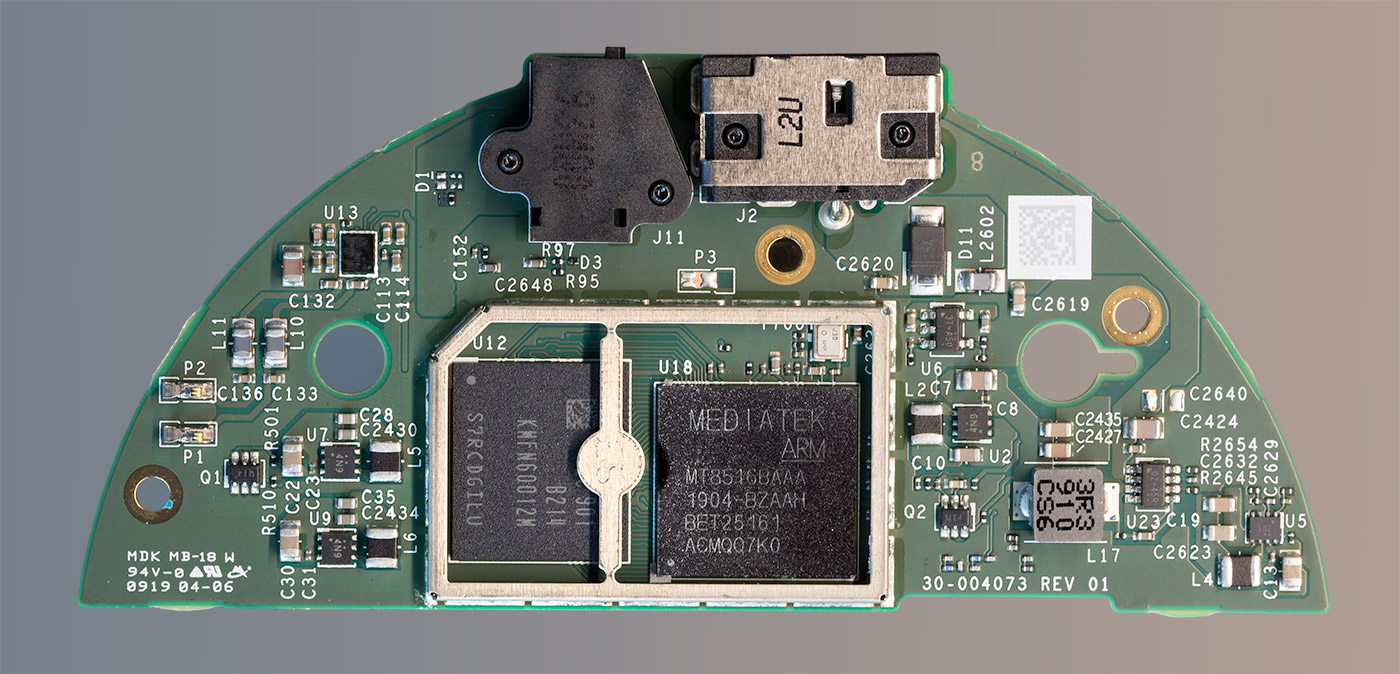
Top PCB with White Plastic surround
The top PCB can be removed from the white plastic ring and top cover by removing the four silver Torx bolts.
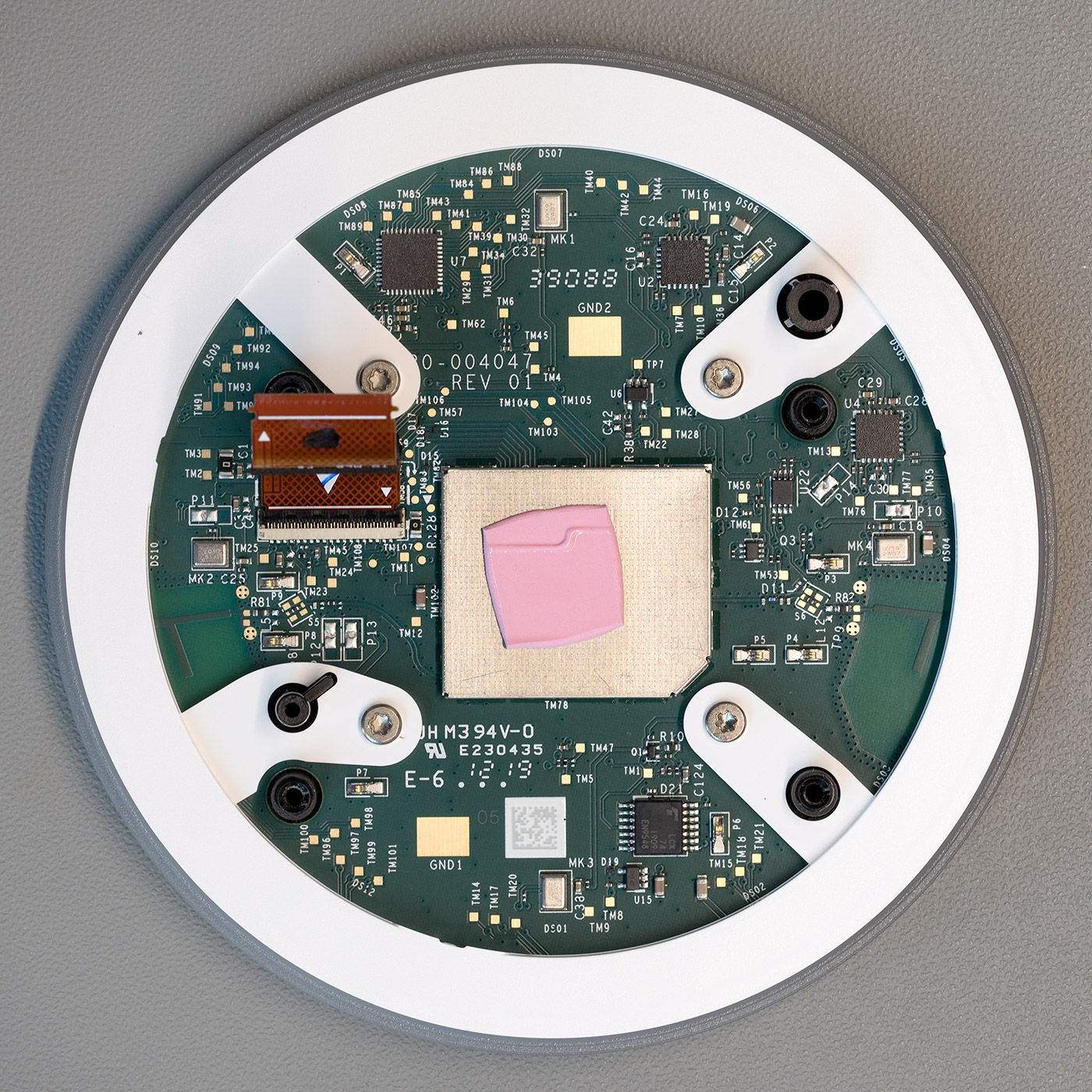
Top PCB with buttons
The top of the PCB contains four buttons, two LEDs and a light sensor.
The LEDs are placed on either side of the button which toggles the microphones on and off. The light sensor controls the brightness of the LED ring array.
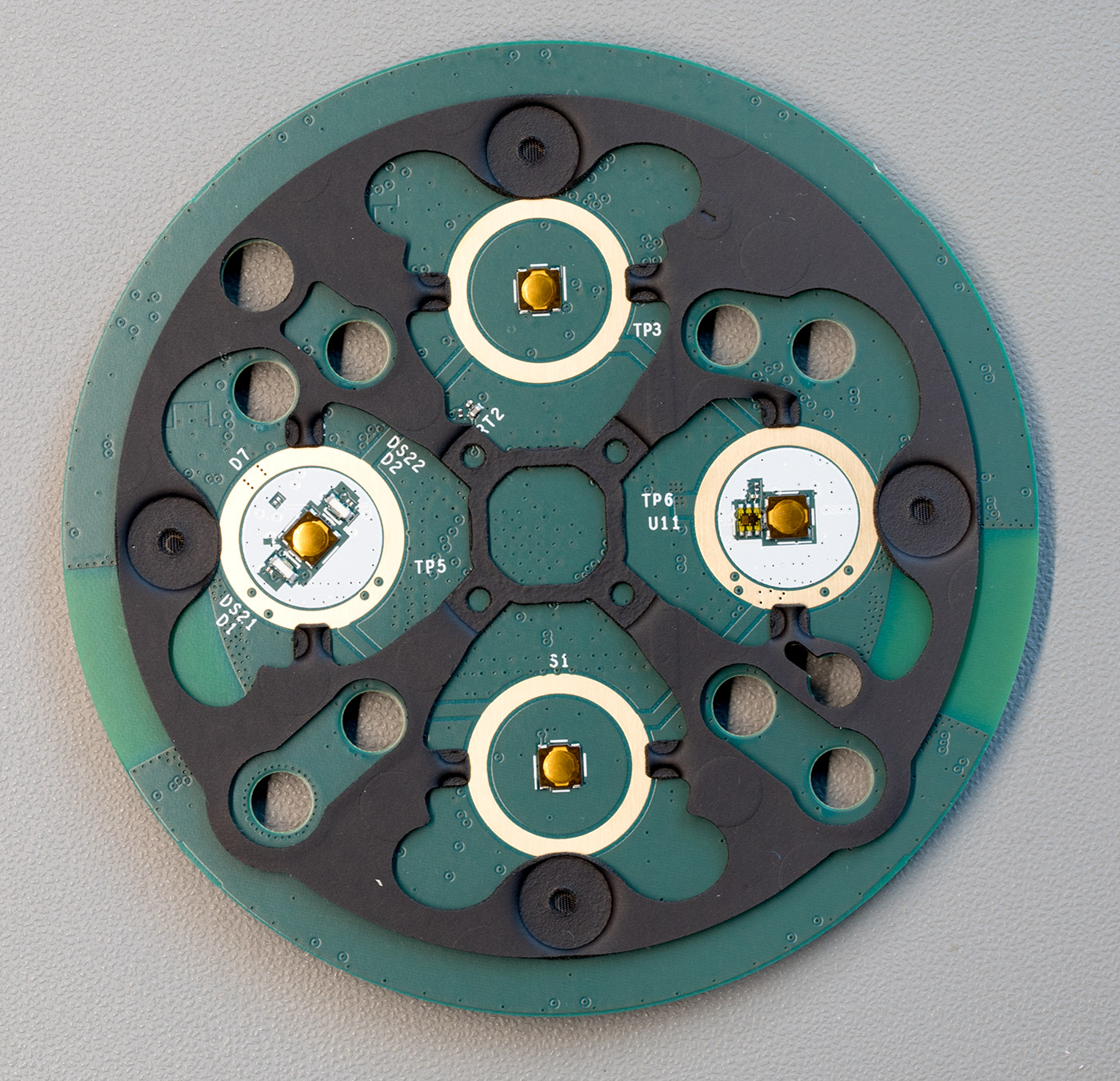
Top PCB with Shielding removed
The underside of the top PCB contains most of the components found inside the Echo Dot. An array of 12 RGB LEDs is located around the edge of the board. The LEDs are driven using an ISSI IS31FL3236 36-channel LED driver.
Four microphones are placed next to the buttons and these feed into two TLV320ADC3101 chips from Texas Instruments. The TLV320ADC3101 is a Stereo ADC with an embedded mini digital signal processor. The Echo dot uses four microphones to locate the direction the voice is coming from and filter out background noise.
In the centre of the PCB is a metal shield. Under the shield, you will find a MediaTek MT7658CSN dual-band Wi-Fi and Bluetooth controller with an ARM Cortex-R4 CPU. The MT7658CSN manages communication to wi-fi and Bluetooth devices and connects to two PCB antennas located on the outer edges of the board.
There is also a Fairchild 74LCX74 dual D-Type flip-flop which appears to switch the microphones on and off.
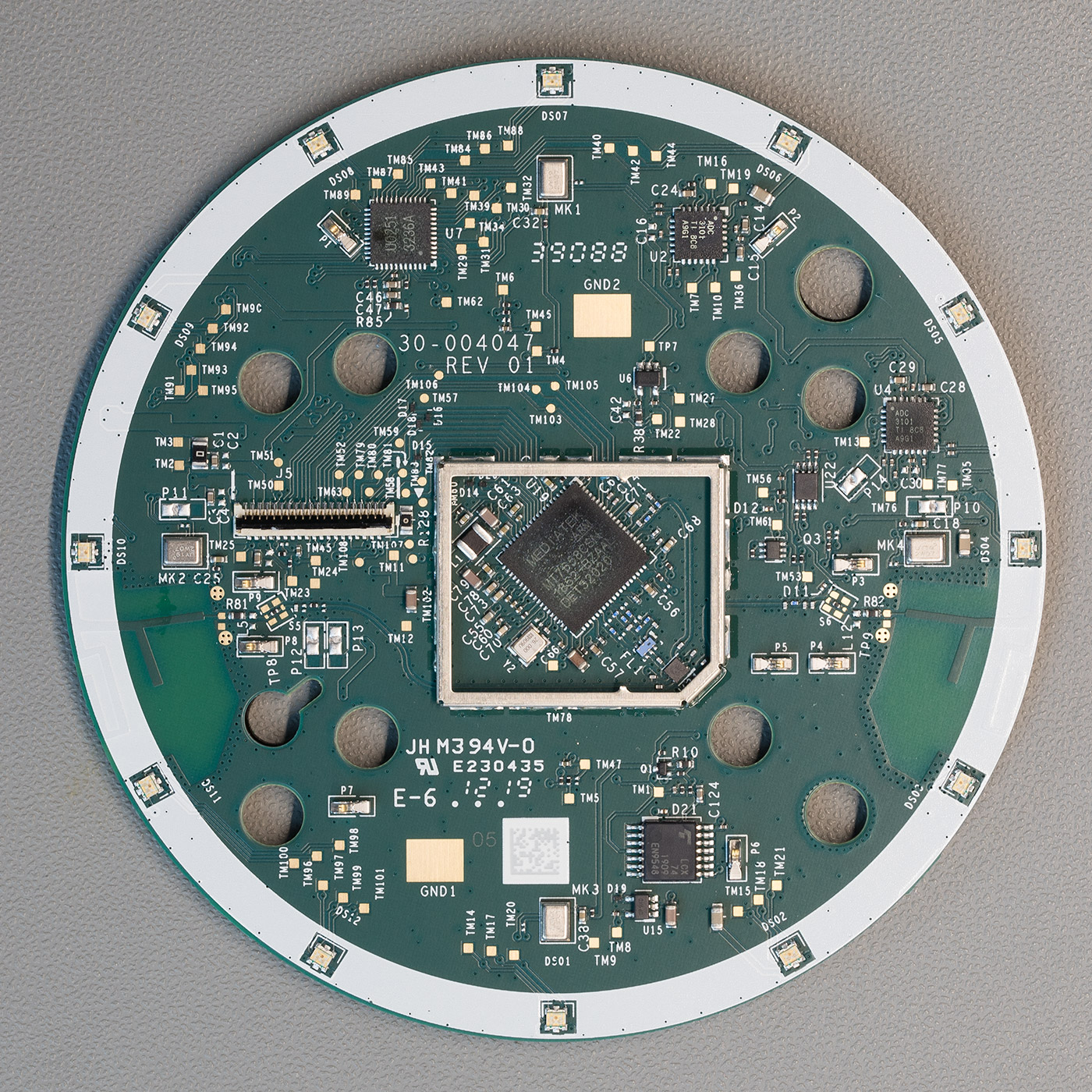
Metal Chassis
The top of the metal chassis.
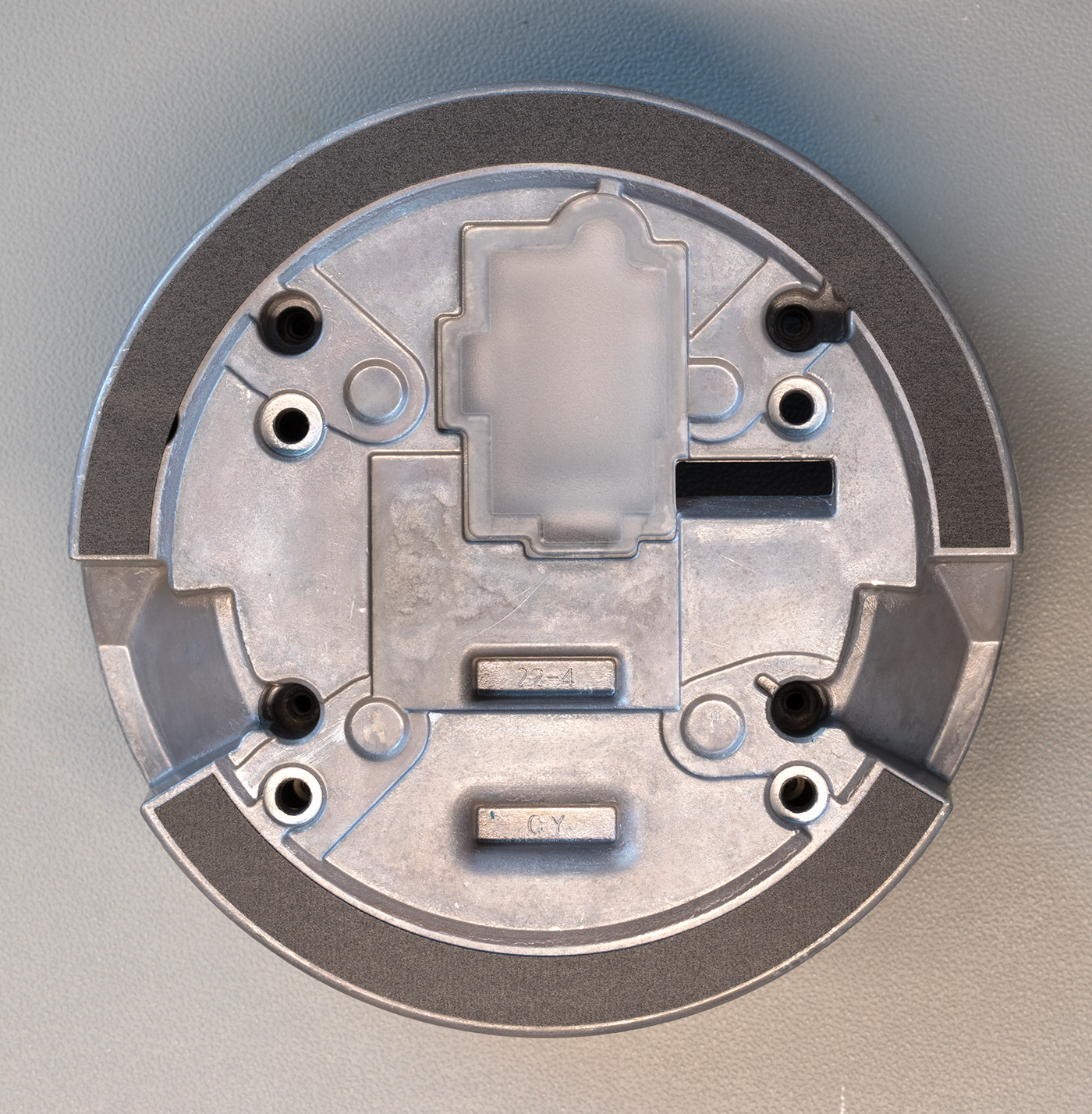
All internal parts
All of the internal parts that make up the echo dot.
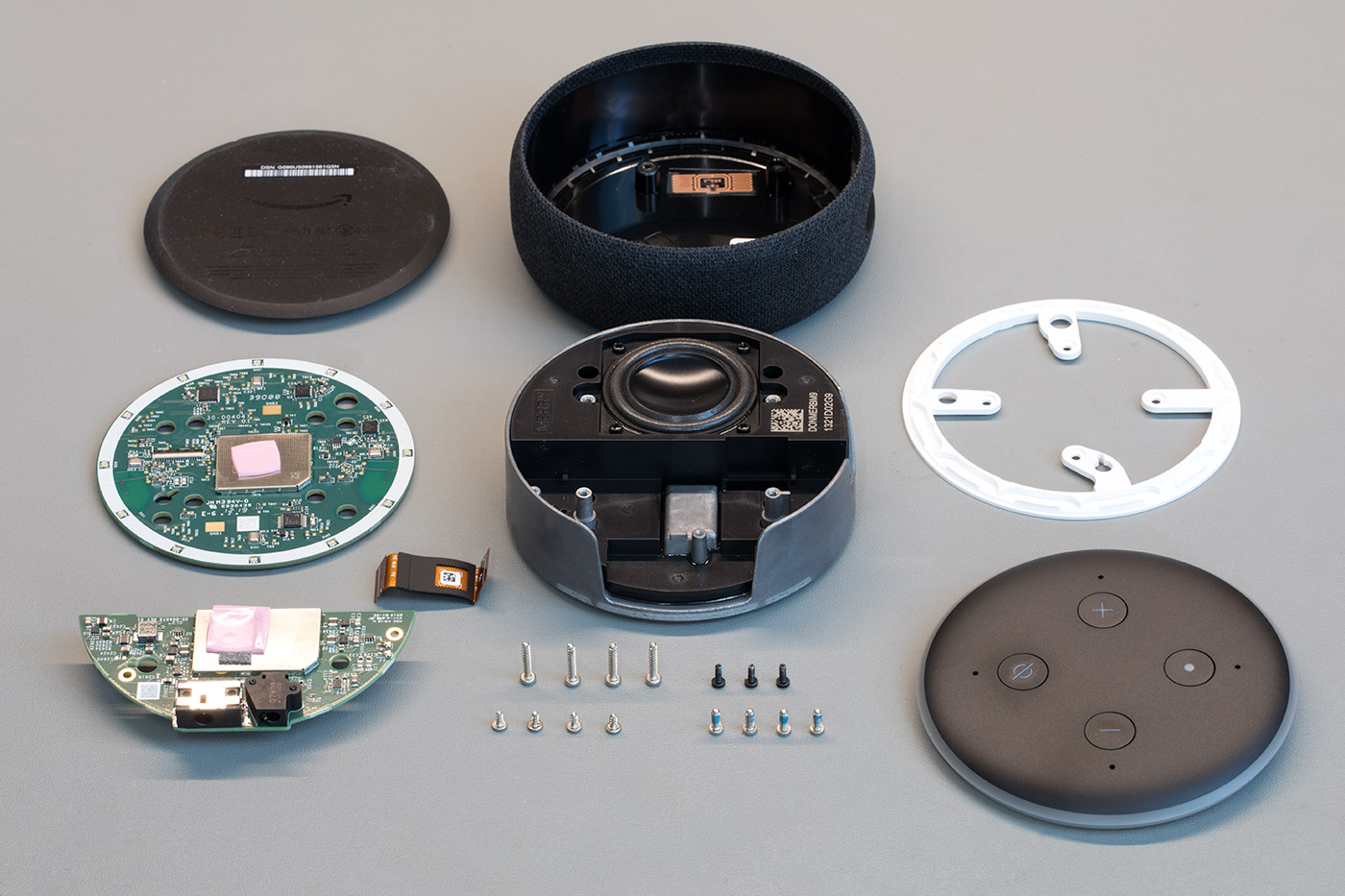

Joe
Nice teardown. Is there a part number for the speaker driver?
Brian
Joe, the speaker driver is a TAS2770 from Texas Instruments. I have updated the post with the driver info
Ricardo
Very interesting, awesome pics btw!
Andrew
Is there a part number for the microphone? This is some great work with the teardown; I want to copy the "light up where the sound is coming from" direction-finding functionality of the Echo
Brian
Andrew, the number on the microphones is UY19 2WO7. I haven't been able to find anything online for this part number.
rahul
What’s the WiFi and Bluetooth chip used? Is it from marvel ?
Anony
I hope the flip flop proves that if we switch off the mics, the software can not switch it on by itself, even after a reboot and it remains true that if muted, it will not feed mic data to anybody(amazon or a hacker).
Gagan
My Echo dot 3rd gen is not searching my "My Air Purifier 2s" of Xiaomi through"Mi Home" app. It says device is not found, whereas Mi Home app is working properly with my device.
Some random guy
Speaker driver : Fg-4040E1-3B
jimmy
Has anyone measured the voltage of the LED lights?
Dave Bailey
If I removed the 4 microphones would it still function? ie. play music from another echo which is controlling it from another room. I'm trying to TOTALLY remove listening possibility for a few of my networked units.
Simone
I think not... probably at boot the device checks for hardware integrity... What are you doing that no one can have a chance to hear?
Mäx
Dave, I came here to ask that exact question. Looks like it’s impossible, though I’m thinking it might be possible to fill them with superglue - that way electronic checks might still work but they won’t be able to “hear”
Jay
Doesn't look like it's using digital microphones (could be wrong, it's not easy to tell from the pictures) they look like fairly 'standard' electret elements which should be fairly simple to disconnect (might need a track cutting per element) and the disconnection would be undetectable (unless Alexa is constantly listening for background noise to ensure hardware integrity which is rather disturbing)
Paul D Williams
Do you happen to know the part number for the tweeter for the 3rd gen Echo Dot? Having a hard time finding any information online. Trying to buy replacement part
Brian
Paul D Williams, I am sorry but i don't know the part number
mbip
I wish in future echo dot will have internal battery.
Anthony
My speaker is distorted. Amazon won't take it back, I want to replace the speaker what do I order?
kat
is there any resources I could find to get a replacement board with the aux and power in?
Liam
Can all components on the boards be colour coded to identify where each one is? Thanks
Paul F Brown
I have vision limitations. Can anyone tell me the size of the led clock on echo dot 3 please
Carl
Hello: I have a big problem, my amazon echo is dead, i followed your teardown and inspected the processor board, I found burned the component U23, do you have idea what kind of component is? MOSFET, Regulator, driver, or something else?, I really need your help.
Brian
Carl, U23 part number is 02=45R It looks like some sort of voltage regulator but we don't know the output voltage.
Larry
Thank you for the pictorial tour of the echo dot. Does it appear to be possible to add a line in port?
EJH
Echo dot speaker is very distorted, anyone know where to get a replacement? Thank you.
Edi
@EJH: If you're lucky, the distortion is just because of some mechanical issues in the loudspeaker (for instance there's a metal part which entered the housing and is being hold by the loudspeaker magnet and which presses on the membrane of the speaker itself). Good luck!
Steve
There does not appear to be a battery. I am quite surprised as I would think Amazon would like to continue listening even when the device is unplugged. For their product development of course. Can anyone confirm that there is no battery.
YSR
What type of microphone is used? Analog or Digital? From numbers on microphone, unable to get microphone details.
Ian
I've searched a many of forums with ZERO answer besides exchange/purchasing a new device - I'm wondering if there is an answer before taking apart or what to look for when I do. Echo dot 3rd gen will not enter setup mode. Tried everything under the sun including trying my roommates cord for theirs, waiting 5 minutes, rebooting router, de/re- registering, and obviously holding action button for at least 25 seconds, etc. Instead of turning orange it turns solid blue indefinitely. I promise I've tried all troubleshooting techniques given, and then some. Thank you in advance for your time!
Happy
can you see how the audio out jack is wired for stereo and the speaker for both L & R channels? Is it the same audio feeding both or is it separated in chip? Is the speaker cutoff a mechanical contact in the audio jack or is that on chip? I am looking for a way to have both speaker and headphones simultaneously.
freakqnc
What's the speaker part number and where can I get a replacement one? As EJH stated earlier "Echo dot speaker is very distorted". Thank you.
Mark E Wright
Can you confirm on the size of the torx screws? thanks
Brian
Mark E Wright, I am sorry but I don't remember the size of the torx screws. Our driver set has had a lot of use and the sizes have all worn away from the handles.
Je'Mari
what's the top part called? the one with the buttons and top cover
Monem Alyaser
Anyone knows the power dissipation of of the Mediatek MT8516BAAA Quad-core, 64-bit ARM® Cortex-A35 MPCore processor
halooie1
Where is the DAC? Integrated into the TAS2770?
Sam
Do you know a part number to replace the top ribbon?
Gerry Teldon
What is the purpose of the dot and diagonal line button. I have a problem hearing Alexa
Scott Petersen
The circle with the diagonal line is to mute the microphone, when active the coloured leds turn red
Dharmesh
Does anyone know what the music power in watts is the Amazon Echo Dot 3rd gen
Julio Lopez
Does anyone know where to buy the speaker driver
Hank
Torx screw size is T6
Arvind
Thanks for excellent review. Could you let me know which DAC chip is used
Martin ALCARAZ
Thanks for excellent review. Could you show led plastic ring back side .
Glenn
Hi, if one of these is getting hot and non-functional, do you think a Raspberry PI could be put in and use the speaker and power port for a headless RPI?
Daniel
Hello, is it possible to replace the flat cable holder on the first board? It seems mine is broken, as the cable doesn't hold good anymore and Alexa won't turn on. Thanks!
Dave
Can you fit a raspberry pi 4 inside the case whilst retaining the speaker
Steve
Everything is here apart from what are the buttons for ?
Luis alberto
Donde puedo comprar la placa del centro de carga y audio al parecer la de mi E3 se quemo debido a una variación de voltaje, o creen q sea posible q se haya protejido debido a q recibió una variacion de voltaje. Por favor que alguien me ayude.
Google translation: Where can I buy the charging and audio center board? Apparently the one in my E3 burned out due to a voltage variation, or they think it may have been protected due to a voltage variation. Please someone help me.
Ra
Nice Breakdown!
Where can I find a DC Output Power Plug for the 3rd Gen. The device does NOT have a Standard DC Plug-in port, (it’s close but not close enough) I would like to make a 12 V mobile power cord.
Francesco
Hello, I was looking to replace the small flat-flex cable with a longer one. Do you know where can I find it and what is the name?
Luiz Gustavo juk
Onde eu posso encontrar o alto-falante da lexa geração 3
Where can I find the alexa generation 3 speaker
Jack Fraser
Hi Brian, my gen 3 dot is "stuck with blue ring and will not factory reset using various reset instructions. It never goes orange, I've tried all the tricks and tips. So I am wondering if I tear it open like you have do you think that could help in some crazy way? Other than a bad chip on the pcb I wasn't sure if I could try something at that level that might work. Any thoughts?
Tim
I am looking for a replacement ribbon cable. Any ideas where I could get that part?
Ian Lewis
I want to mount on the ceiling, therefore do you think I should be able to re-route the power cable/socket?
Brian
Ian, it should be possible to attach power cables inside the case and drill a hole in the base to have the cable exit for mounting on the ceiling
Claudio
I've the same issue Ian Lewis has. any hints?
Hussain
Where i can find that internal speaker of dot 3, any part number
Stefan Wulph
Great tare down and LOTS of good info.
My questions are:
What kind of LEDs does the 'ring' use? IE WS2818 IA RGB LEDs?
How big is the internal speaker? WATT and actual size in/cm?
Many Thanks :)
David Clarke
Great teardown, mine keeps losing WiFi, I can now check the WiFi aerial, thank you
Pete
Looking for RGB LED manufacturer and part number so I can replace bad part. Want to use same so color matches others. Anyone know answer?
Arek
Hello, does anyone know what the converter marked on the PCB as U23, the marking on it is 02 = 45t, this element is burnt for me. I will be grateful for any help.
Mickey
Hi,
Any information on the LED ring diffuser material and how it is mounted/ integrated on casing?
TinkyWinky
My echo Dot speaker has a tear in it. Needs to be replaced, still has sound but it is muted. Found the speakers on ebay but they come from China. 1.6 inch 40MM Amazon Amazon Echo dot3 smart speaker original neodymium magnetic full frequency speaker 4 Euro 8W Located in: shenzhenshi, China. :(
Jijoy
Can we buy speaker parts?
BionicTim
I also found this in Amazon...
40MM 4ohm 8W Neodymium full frequency speaker Loudspeaker.
Faraday
@Anthony you order another, change the speaker and send it back
Shree
What is that connecting orange strip called?
Brian
The orange strips are called flat-flex cables.
Isac
Is the same mic used on the echo dot 4th and 5th gen?
Brian
They appear to be the same microphone modules
José
do you know the part number of the power input jack? The one that is marked as L2U
Brian
I am sorry but I do not know the part number for the power jack.
Mark M
Great teardown! Saw someone has an identical problem with no answer, the unit only has a circling blue light, no reset function works. Is the an internal point of reset made available by teardown?
Pratyush
Can that Alexa echo dot 3 work without the body i.e. with only the pcbs?
Brian
It should work ok without the body
Pallav Aggarwal
Great Teardown and details. Recently I have also started doing teardowns (pallavaggarwal.in) to learn how consumer electronics are designed for mass manufacturing and low cost. very interesting to learn so much in the process.
Rajesh Kumar
Hamare device Alexa per sound fatafat a raha hai to mujhe lag raha hai voltage to theek hai speaker change karna padega kya speaker mil jaega aur uska price kya rahega mujhe bataiye dhanyvad
From Google Translate: Please tell me what speaker will be available and what will be its price. Please tell me what is the problem with our device Alexa per sound.